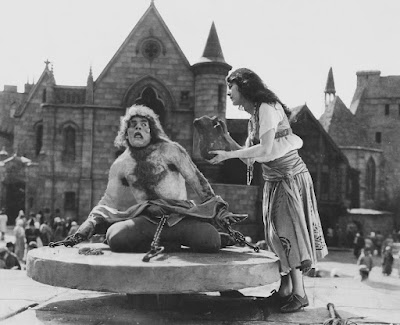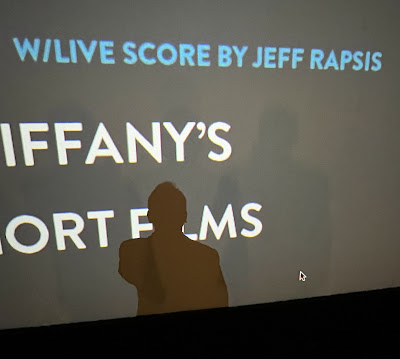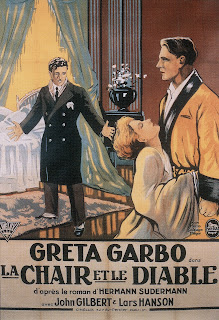Buster Keaton cooks up some well-timed comedy in 'The Navigator' (1924).Never mind the Superbowl—I'm attending a pair of 100th birthday parties this weekend!
This afternoon (Saturday, Feb. 10), it's Buster Keaton's 'The Navigator' (1924), which I'm accompanying at 4:30 p.m. at the Jane Pickens Theatre in Newport, R.I. More info in the press release pasted in below.
Then tomorrow (Sunday, Feb. 11), it's the original big screen adaptation of 'Peter Pan' (1924), for which I'll do music at 2 p.m. at the Somerville Theatre in Somerville, Mass. I've pasted that press release in below as well.
I think the Keaton screening is intended as a warm-up to Valentine's Day, while 'Peter Pan' is clearly family counterpoint to the Superbowl, which takes place later that day.
Well, whatever reason works for you, hope you can join us and take in one or both screenings this week. Besides being the date of this year's Superbowl, Sunday also happens to be National Guitar Day and also National Autism Day.
I don't know about you, but I can't think of better reasons to celebrate with a silent film screening!
See you at the movies!
* * *
Dressed for diving: Buster Keaton in 'The Navigator' (1924).MONDAY, JAN. 15, 2024 / FOR IMMEDIATE RELEASE
Contact Jeff Rapsis • (603) 236-9237 • jeffrapsis@gmail.com
Classic silent seafaring farce ‘The Navigator’ (1924) at Jane Pickens Theatre on Saturday, Feb. 10
Buster Keaton's nautical masterpiece to be screened with live music at historic venue in downtown Newport, R.I.
NEWPORT,
R.I.—He never smiled on camera, earning him the nickname of "the Great
Stone Face." But Buster Keaton's comedies rocked Hollywood's silent era
with laughter throughout the 1920s.
Acclaimed for their
originality and clever visual gags, and also admired for their authentic
location shots and amazing stunts, Keaton's films remain popular
crowd-pleasers today.
See for yourself with a screening of 'The
Navigator' (1924), one of Keaton's landmark feature films, on Saturday,
Feb. 10 at 4:30 p.m. at the Jane Pickens Theatre Film and Event Center,
49 Touro St., Newport, R.I.
The screening, the latest in the
venue's silent film series, will feature live accompaniment by Jeff
Rapsis, a New Hampshire-based composer who specializes in creating music
for silent films.
Admission is $16 per person. Tickets available online at https://janepickens.com or at the door.

'The
Navigator' is a comedy that follows the adventures of wealthy nitwit
Rollo Treadway (Keaton) and his pampered girlfriend, who find themselves
adrift alone on a massive ocean liner. Forced to fend for themselves
without servants, the pair attempt to cope with day-to-day life,
creating classic comedy in the process.
But when the ship runs aground on a remote island inhabited by cannibals, is Buster's resourcefulness enough to save the day?
Filmed
at sea on a real ocean liner that Keaton treated as the largest prop in
comedy history, 'The Navigator' has been hailed as one of the most
original and distinctive movies to come out of silent film's golden era
of comedy.
The film is highlighted by underwater scenes, with
Keaton in an oversized antique diving suit, that were revolutionary at
the time.
A remarkable pantomime artist, Keaton naturally used
his whole body to communicate emotions from sadness to surprise. And in
an era with no post-production special effects, Keaton's acrobatic
talents enabled him to perform all his own stunts, including some
spectacular examples in 'The Navigator.'
Rapsis, a New
Hampshire-based silent film musician who accompanies shows at venues
across New England, said Keaton's films weren't intended to be shown on
television or viewed at home.
In reviving 'The Navigator' at the
Jane Pickens Theatre, organizers aim to show silent film as it was meant
to be seen—in high quality prints, on a large screen, with live music,
and with an audience.
"All those elements are important parts of
the silent film experience," said Rapsis. "Recreate those conditions,
and classics of early Hollywood such as 'The Navigator' leap back to
life in ways that audiences still find entertaining."
Rapsis
performs on a digital synthesizer that reproduces the texture of the
full orchestra, creating a traditional "movie score" sound. He
improvises the complete score in real time during the screening
"Creating
a movie score on the fly is kind of a high-wire act, but it can often
make for more excitement than if everything is planned out in advance,"
Rapsis said.
'The Navigator' (1924) starring Buster Keaton will
be screened with live music on Saturday, Feb. 10 at 4:30 p.m. at the
Jane Pickens Theatre Film and Event Center, 49 Touro St., Newport, R.I.
Admission is $16 per person. Tickets available online at
https://janepickens.com or at the door. For more information, call the box office at (401) 846-5474.
Critic comments on 'The Navigator':
"The
Navigator looks and feels like it could be one of today's summer
mega-blockbusters. It has a great, simple premise that includes the
destroying of a huge set. It's endlessly imaginative, funny, inventive,
etc. It's one of the greatest movies I have ever seen."
—Jeffrey Anderson, Combustible Celluloid, 2001"His
comic timing is brilliant. He says more in his face than most actors
today do with their face and voices. It's a very funny story with dozens
of very memorable comic scenes. A true classic."
—James Higgins, Turner Classic Movies, 2011* * *
An original release poster for 'Peter Pan' (1924).TUESDAY, JAN. 30, 2024 / FOR IMMEDIATE RELEASE
For more info, contact: Jeff Rapsis • (603) 236-9237 • jeffrapsis@gmail.com
Rarely seen silent film version of 'Peter Pan' at Somerville Theatre on Sunday, Feb. 11
Original big-screen adaptation of magical fantasy classic, a major 1924 hit, to be shown in 35mm with live musical score
SOMERVILLE,
Mass.—It was the film that introduced movie-goers to visions of flying
children, magical fairies, human-like animals and menacing pirates.
It
was the original silent film adaptation of 'Peter Pan,' a picture
personally supervised by author J.M. Barrie. The film was a major hit
when released in 1924, with audiences eager to get their first
big-screen look at the wonders of Neverland.
Movie fans can see
for themselves when the first 'Peter Pan' (1924) is screened in 35mm on
Sunday, Feb. 11 at 2 p.m. at the Somerville Theatre, 55 Davis Square,
Somerville.
The program will feature live music for the movie by
silent film accompanist Jeff Rapsis. General admission tickets are $16
per person; seniors/children $12; tickets available online at www.somervilletheatre.com or at the door.
Thought
lost for many years, and overshadowed by more recent adaptations, the
original silent 'Peter Pan' maintains its freshness and charm nearly a
century after its original release.
In the story, first presented
as a stage play in 1904, three children in London are visited one night
by Peter Pan, a youth in search of his shadow. Pan shows his new
friends how to fly, and then convinces them to join him in a journey to
Neverland.
There they encounter Indians, mermaids, and a band of
pirates whose leader, Captain Hook, is Pan's sworn enemy. The children
are captured by Hook and taken prisoner aboard his pirate ship, setting
the stage for an epic battle, the outcome of which will determine if the
children may ever return home.
Though the Peter Pan story is
well-known today due to subsequent adaptations (and also merchandising
that includes a ubiquitous brand of peanut butter), the tale was
virtually new when Hollywood first brought it to film in the early
1920s.
In England, author Barrie gave his blessing to the
first-ever screen adaptation, though he retained control over casting
and insisted that any written titles in the film be taken directly from
his own text.

After a major talent search, Barrie settled on
unknown 18-year-old actress Betty Bronson for the title role, and
filming began in 1924. The role of Captain Hook was played by noted
character actor Ernest Torrence, who invented the now-iconic villainous
pirate persona that would become a Hollywood legend.
The film's
highlights include special effects that maintain their ability to dazzle
even today. The film's memorable images include a group of mermaids
entering the sea, a miniature Tinkerbell interacting with full-sized
children and adults, and a pirate ship lifting out of the water and
taking flight.
'Peter Pan' also includes a cast of animal
characters played by humans in costume, including the family dog Nana
and an alligator who serves as Hook's nemesis, lending the film a
magical quality.
After the film's release, no copies of the
original 'Peter Pan' were known to exist, and for many years the film
was regarded as lost. However, in the 1950s a single surviving print
turned up in the George Eastman Archives in Rochester, N.Y., from which
all copies today have descended.
Accompanist Jeff Rapsis
specializes in creating live musical scores for films made prior to the
introduction of recorded sound. Rapsis creates film scores in real time,
as a movie is running, using a digital synthesizer to reproduce the
texture of a full orchestra. He averages about 120 performances per
year, and has created music for more than 380 different silent feature
films.
"Improvising a movie score is a bit of a high wire act,
but it can result in music that fits a film's mood and action better
than anything that can be written down in advance," Rapsis said. "It
also lends a sense of excitement and adventure to the screening, as no
two performances are exactly alike."
'Peter Pan' is the latest in the Somerville Theatre's 'Silents, Please' series.
The
series gives movie-goers a chance to rediscover the experience of
silent cinema presented as it was intended: on the big screen using 35mm
prints, with live music, and with an audience.
"If you can put
all the original elements together, the films of early Hollywood still
come to life," said Rapsis. "These are the films that caused people to
first fall in love with the movies."
‘Peter Pan’ (1924) will be
shown on Sunday, Feb. 11 at 2 p.m. at the Somerville Theatre, 55 Davis
Square, Somerville, Mass. Admission $16 per person; seniors/children
$12. For more information and to purchase tickets, visit
www.somervilletheatre.com or call the box office at (617) 625-5700.


































